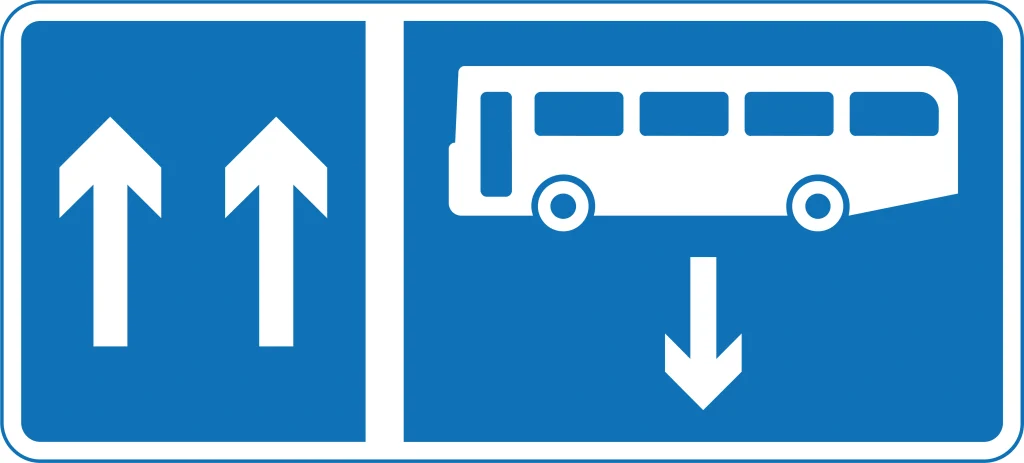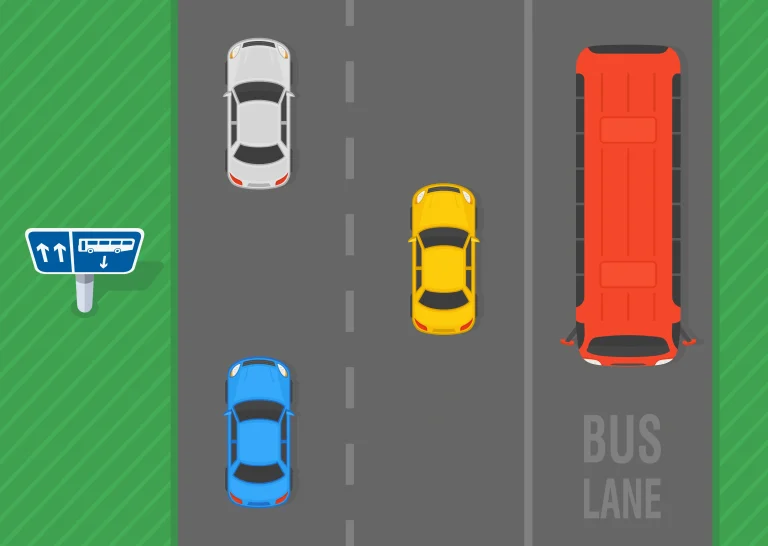If you’re studying for your theory test, you may have come across the question: “Where would you see a contraflow bus lane?”
So, pop quiz time. Is it:
- Near a roundabout
- On a dual carriageway
- On a one-way street
- On an urban motorway
The answer is “3” — on a one-way street.
Here, we explain what a contraflow system is, why they’re necessary, and why contraflow bus lanes (and cycle lanes) are found on one-way streets.
- What is a contraflow system?
- So, what is an example of a contraflow?
- How can you recognise a contraflow system on a motorway or dual carriageway?
- What would you expect at a contraflow system?
- Where would you see a contraflow bus lane?
- How do you recognise a contraflow bus lane?
- What do you need to know when driving near a contraflow bus lane?
- What about a contraflow cycle lane?
- A few more FAQs
- In summary
What is a contraflow system?
A contraflow system is one where vehicles travel in the opposite direction than normal. “Contra” means “against”, and “flow” refers to the movement of the traffic.
Contraflow systems can be temporary or permanent, depending on the reason behind them and the location.
So, what is an example of a contraflow?
Due to the vast amount of traffic driving on motorways and dual carriageways, a lot of maintenance is required to keep roads in tip-top condition. But the high speeds allowed on these roads can result in more serious accidents for the crew involved, so the work has to be undertaken carefully.
Maintenance and emergency service workers must be safely separated from oncoming traffic. This is where a contraflow system comes into play.
Here’s why:
- Normally, traffic on a motorway or dual carriageway is separated by a central reservation (the narrow strip of land used to divide opposing traffic flows).
- Everyone on your side of the central reservation will be travelling in the same direction. In other words, “with-flow” traffic.
- Often, when minor roadworks take place, one or two lanes may be shut. As a driver, you’ll have to merge into the open lane and observe a temporary speed limit, but you’ll still be separated from oncoming traffic by the central reservation.
- However, for more extensive roadworks or following a major accident, all the lanes may be closed. This allows workers or emergency services to deal with the situation safely without the risk of high-speed traffic passing nearby.
- When this happens, the traffic from the closed side will be diverted across the central reservation, creating a contraflow system.
- You’ll be separated from oncoming traffic by cones or temporary barriers and asked to observe a reduced speed limit. The lanes may be narrower than normal to maintain a safe distance from vehicles travelling in the opposite direction.
- Once you’ve passed the scene of the works or accident, you’ll be diverted back across the central reservation, where you can resume your journey at a higher speed.
How can you recognise a contraflow system on a motorway or dual carriageway?
You should be warned well in advance if you need to join a contraflow system on a motorway or dual carriageway.
If there are overhead lane signs, you’ll probably see red flashing signals or red Xs to indicate that the lanes are closed and that you need to prepare to change lanes.
As you approach a contraflow, you should also see the yellow contraflow system sign below. The arrows instruct you to stay in your lane and follow the traffic flow as it crosses the central reservation. The sign also indicates the reduced speed limit you must obey as you drive through the temporary contraflow system.

What would you expect at a contraflow system?
When driving in a contraflow system, the main things to consider are your speed and whether you’re in the right lane. Make sure you slow down as you approach the system, get in the correct lane early, stay in that lane, and follow the vehicles in front of you from a safe distance.
Once you’re in the contraflow system, do not attempt to overtake and make sure you stay within the cones, otherwise you’ll meet oncoming traffic. Stick to the reduced speed limit throughout, and be aware of the additional hazards around you. These include:
- Narrower lanes
- Fewer (or no) protective barriers
- Obstructed hard shoulder
- Roadworks
- Broken down or damaged vehicle(s)
- Debris from an accident
- Close oncoming vehicles
Once you reach the end of the contraflow, follow the signs to safely rejoin the original side of the motorway or dual carriageway.
Where would you see a contraflow bus lane?
You’ll typically see a contraflow bus lane on a one-way street. They’re particularly popular in the centre of major cities because they help buses get to their destinations quicker.
While contraflows on motorways are usually temporary, contraflow bus lanes tend to be permanent features.
By travelling in the opposite direction of oncoming traffic, buses can take a more direct route through a city centre’s one-way street network, shortening their travel time and improving public transport efficiency and reliability.
Contraflow bus lanes also help to reduce congestion by separating buses from the main flow of one-way traffic.
How do you recognise a contraflow bus lane?
The blue rectangular sign below indicates that a contraflow bus lane is in operation. The arrow below the image of the bus highlights that buses will be travelling in the opposite direction to oncoming traffic.
It’s also worth noting that in some cities, bus lanes are painted a different colour to discourage motorists from entering them and to warn pedestrians of traffic coming from the other direction.

What do you need to know when driving near a contraflow bus lane?
You need to take a few extra precautions when driving near a contraflow bus lane:
- Pay attention to the signage and road markings that indicate where a contraflow bus lane begins and ends
- Give yourself plenty of time to get into the right lane, if necessary
- Do not enter the bus lane at any point
- Give way to buses pulling into or out of these lanes
What about a contraflow cycle lane?
Like a contraflow bus lane, you’ll typically find a contraflow cycle lane on a one-way street.
One-way streets can be dangerous and inefficient for cyclists, and cyclists often ride on pavements to avoid them. However, this can put both cyclists and pedestrians at risk. Separate contraflow cycle lanes offer a safe and direct route, and help cyclists to avoid busy roads and hazardous junctions while keeping them off pavements.
As a driver, you need to recognise contraflow cycle lanes from the white lines and road signs (similar to the contraflow bus lane sign, only with an image of a bicycle) and make sure you give cyclists plenty of room.
Sometimes, contraflow bus and cycle lanes are merged, allowing both buses and cyclists to travel in the opposite direction to oncoming traffic.
A few more FAQs
Can vehicles other than buses use a contraflow bus lane?
Most contraflow bus lanes are for buses only. However, in some towns and cities, cyclists, taxis, and emergency vehicles can also use contraflow lanes on one-way streets. It all depends on the local rules and regulations. As a driver, it’s your responsibility to observe signs and road markings at all times.
What is a with-flow bus lane?
A with-flow bus lane is one that runs in the same direction as the traffic alongside it. Sometimes, taxis and cyclists are also permitted to use with-flow bus lanes. Depending on the local rules, with-flow bus lanes may be used by cars and other motorists outside of the hours of operation.
What times can you use bus lanes in the UK?
Most bus lanes in the UK operate at peak travel times (usually between 7:30am and 9:30am and 3:30pm and 6:00pm). Outside of these hours, the lanes can be used by all road users.
However, these times can vary depending on where in the UK you’re driving. Always double-check the hours of operation before entering a bus lane, as driving in one while it’s in use could result in a fine.
In summary
To recap, a contraflow bus lane is usually found on a one-way street, typically in the centre of a major town or city.
By travelling in the opposite direction to oncoming traffic, buses (and sometimes cyclists, taxis, and emergency vehicles) can take shortcuts through busy streets and junctions, shortening their travel times and reducing congestion.
Starting your journey towards becoming a new driver? Get a learner driver insurance policy you can trust. Find out more here.
Also read:
- Do parking tickets affect insurance?
- How many questions are in the theory test?
- Your guide to the Pass Plus Scheme
- Free MOT status checker – Check a vehicle’s MOT history
- Try our free-to-use Car Tax Checker

